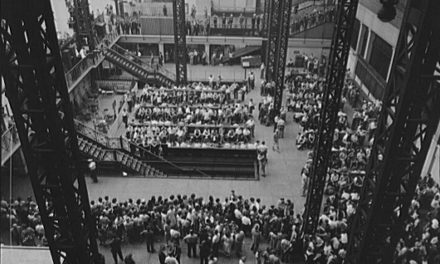By Julie Trien & Iulia Vesel
“American farmers have been too harassed, trying to harvest a bounty crop with scarce labor growing scarcer every day” says Ed Will, the self-proclaimed voice of the middle class farmer.
In addition to farmers’ workload, a new price ceiling could add to their stresses.
The Office of Price Administration (OPA) recently announced its intention to set a temporary price ceiling on milk, with an initial time limit of 60 days. This initiative will decrease the amount of money producers receive for the sale of milk.
While a specific figure was not mentioned, the OPA said the new amount will “represent the best prices producers have received for raw milk since November, 1923.”
According to the organization, to ease the impact this development will have on farmers, the OPA is looking into ways to decrease the prices of alfalfa and hay, popular food for livestock.
However, according to first-hand accounts from farmers, the OPA has made quite an impact on their lives since the war began.
In an essay in The Saturday Evening Post last month, Ed Will described his experience as a farmer living near Odessa, NY. He detailed his life in a system marked by unfair payment for goods and a rapidly dwindling labor force.
“I do not know of single bathroom installed in a middle-class farm that was paid for out of farm earnings,” he said.
Will added that he has seen people leave their crops withering away in the dirt because they decided they would have a better future working in a factory or other industrial job. Many farmers also seek out industrial work as a means of supplemental income to afford farm machinery.
Will said most of his New York colleagues work 60-hour weeks with their schedule dictated almost solely by the needs of the war.
Even though these producers are trying to save money where they can, lights have to be turned on three hours before daylight to prepare the cows for milking and meet with the demand of milk-train schedules.
Carsten Kuehl, a farmer in Gretna, Neb., estimated his work week to be even longer, at 13 to 14 hours a day for six days out of the week. He even does some of his work on Sundays. Together with his son-in-law and son, he milks 16 cows, feeds a herd of 90 hogs and tends to a flock of 350 hens.
Kuehl, aged 51, said he fears losing both family members to the war as men are being drafted younger and younger. With this fear, he began employing the help of grade-school children to help with labor around the farm.
“Now that they are beginning to reach down for the boys of 20 and the young, married men [for the draft], we’ve got a farm labor problem that is real,” he said.
For example, in 1942, the Los Angeles Times heralded nine-year-old David Akin of Quaker Hill, NY for his patriotism in helping his father run a farm after the last of their employees left for a factory job. The boy learned to milk a cow at age three and was driving the family’s tractor by the time he turned nine.
The labor shortage has been a burden for farmers not only in New York, but also around Baltimore, Washington and Philadelphia. The yearly consumption of milk in Washington averages at 359 million pounds a year. About 20 percent of that comes only from Kent and Queen Anne’s Counties, which are now endangered by this shortage.
Will explained that farmers tend to receive poor payment because the sum they receive is based on an outdated comparison system. He suggested that this was the primary reason for farmers are leaving their fields.
He said the system for setting price ceilings, the parity formula, compares the prices farmers received from 1910 to 1914 and multiplies that by the cost of supplies for farms today.
The basis for comparison on which this formula operates may seem logical, as 1910 to 1914 was the last pre-war period not marked severe economic downturn. However, it does not take into account how society has changed.
For example, this formula does not include the rising cost of labor. It also fails to consider the fact that the quality standards for food have risen since 1914.

Farm laborers in Southington, Conn., May 1942. Photo by Fenno Jacobs (from Library of Congress).
Since farmers are expected to produce high-quality food without the necessary adjustments to labor cost, they often find themselves ensnared in a labor shortage. This directly translates into chronic food shortages because farmers are unable to meet demands. In fact, in the struggle to supply Americans with adequate food, the overall quality of certain products seems to be on the decline, according to observations by Kent County agricultural agent, J.D. McVean.
McVean said that, in terms of milk production, the most prominent hardship dairymen are encountering is the low levels of protein in the animal feed, which is vital for high milk production.
“The situation couldn’t be more serious,” he said. He predicts the shortage will be “still more serious next fall.”
In response to these shortages, farmers are forced to adapt their strategies to cope with the loss of different resources.
Farmers explained that nitrogen is essential in having a fertile soil. As a substitute, planting clover and alfalfa also helps the soil as they are high in phosphoric acid and potassium. Officials say these are perfectly fitted substitutes for nitrogen and should be able to help the farmers out in the spring when planting.
One other way farmers have to handle this crisis is by selling a big portion of their cattle for profit. They auction off their livestock or slaughter them and sell the product to nearby butcheries. That is a direct result of the fact that the price of milk is so low that farmers would much rather sell their cows for meat rather than wait for the profits coming from milk.
The Washington Post’s Mark Sullivan explained that it takes three years to raise a cow for milk. Therefore, a shortage in the number of cows will affect the milk production within in the next three years. In the long term, this auctioning will affect the cow population greatly, as more cows will be used for beef and not milk.
However, the New York Times explained that there is a silver lining in this situation. Corn, for example, when used to feed cattle, increases in value of pork or beef by an upwards of 50 cents.
The substitutes officials offer for fertilizers alleviate some of the burden these shortages have brought. The government is giving farmers a lower price on grain in order to use as animal feed as well. With this aid, livestock numbers are predicted to increase.
The quality of life for farmers seems dictated not only by their ability to adapt but also by their geographic location. From the farmer in New York with failing crops and no working bathroom, to the farmer in the Midwest with sprawling land and no labor force, these individuals face mounting pressure to meet the needs of war. Even with certain policies in place to aid them, only time will tell if they can overcome their current obstacles.
Sources:
- “Farmer, 1942.” The Los Angeles Times, Sept 23, 1942.
- “I Speak for the Middle-Class Farmer.” The Saturday Evening Post. Jan 30, 1943.
- “A Farmer Replies to His Critics.” The New York Times. Oct. 18, 1942.
- “Manpower Leaves Farms: Food Shortage Threatens.” The Washington Post, Feb 8, 1943.
- “Midwest Farms Prepare to Fill War Granaries.” New York Times, Jan 31, 1943.
- “Eastern Shore Milk Output Endangered.” The Evening Star, Feb 8, 1943.
- “Ban Effective Today On Store Milk Sales of Less Than a Quart.” The Evening Star, Feb 1, 1943.
- “Farmers Facing Hardest Test as Managers in 1943.” The Chicago Tribune, Feb 9, 1943.
- “OPA to Limit Price Farmer Gets for Milk.” The Washington Post, Feb 9, 1943.





